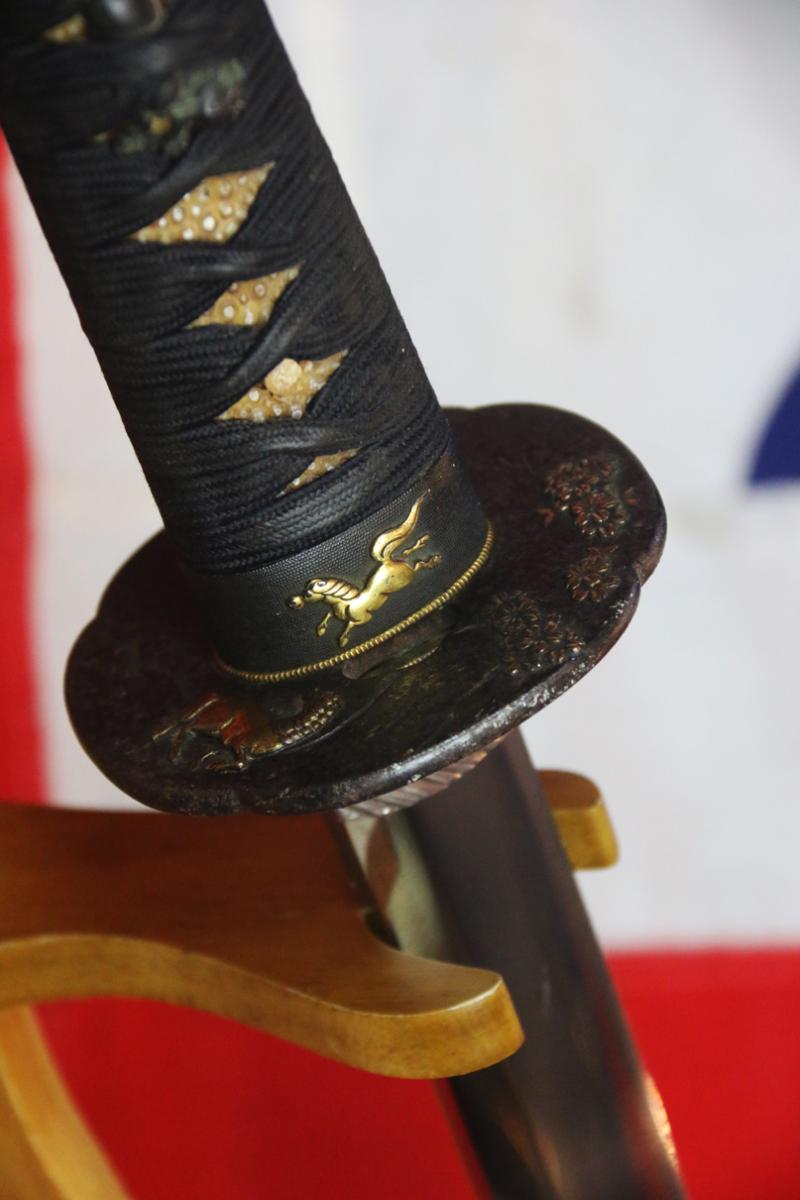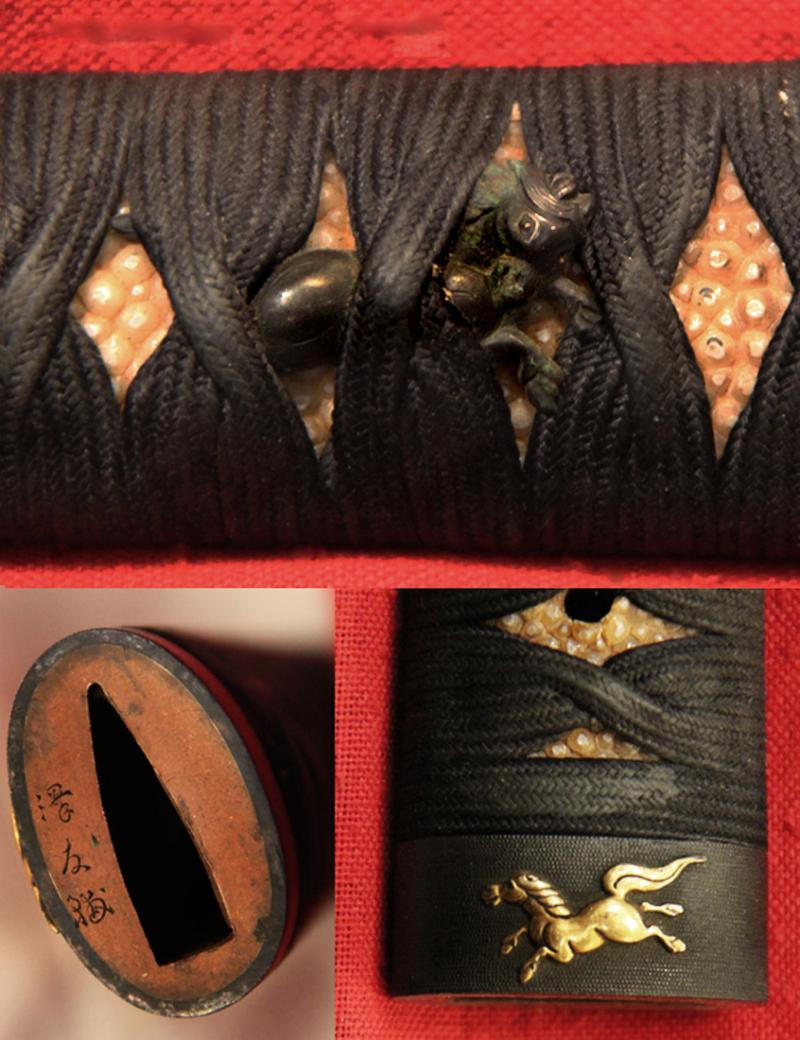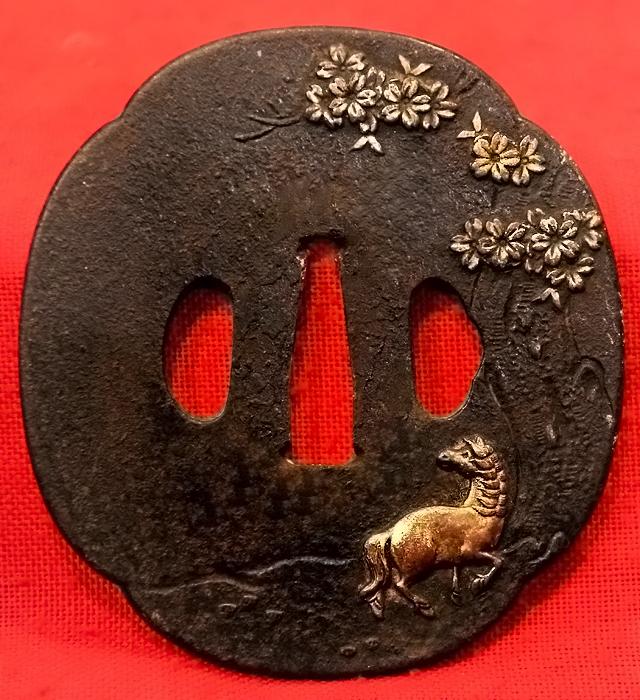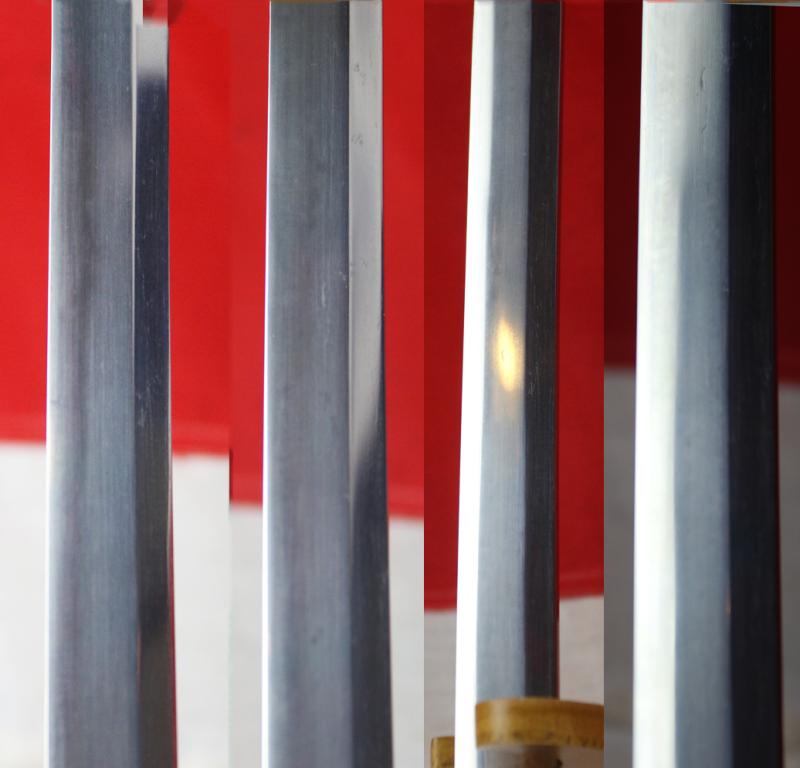A Very Fine & Very Beautiful 'Samurai Pony' Fitted Katana, Signed and Attributed to Hizen Kuni ju Tadayoshi, Circa 1640. With A Simply Stunning Blade with An Amazing Hamon
The whole sword is an fine beauty, fitted with excellent quality and finest gold enhanced mounts, Its fittings are stunning, Edo Period, koshirae mounts of depictions of galloping and grazing samurai ponies throughout. This fine samurai sword has been completely untouched since it arrived from Japan as an esteemed antique gift some 145 years ago, but has now just returned from a blade polish conservation that took four months and looks amazing, The new photos have now been added.
The signed blade bears a stunning and most beautiful hamon temper line, with incredible extravagance and activity.
The fushi is sublime, premier quality, with a pure hammered gold pony over a shakudo nanako ground, and it is signed by the fitting maker. The menuki are shakudo ponies, and the tsuba of a grazing pony enhanced with gold, beneath a gilt flowered cherry blossom tree, on a mokko form iron plate ground.
It has excellent hand applied Nanako Ji: "fish roe ground" A surface decoration produced by forming very small raised bosses by a sharply struck punch or burin called 'nanako tagane'. Shakudo is the metal most often used, but copper and gold are quite often employed. The harder metals, shibuichi, silver and iron are rarely decorated in this way. The size of the dots vary from 0.04" to 0.008" (25 to 125 and inch) and the regularity of the work is marvelous as the dots must be spaced entirely by touch. The dots are usually arranged in straight lines or in lines parallel to the edge of the piece being decorated, but sometimes in more elaborate patterns. Used on guards since the Momoyama period although the technique existed since much earlier periods. Usually done by specialist 'nanako-shi', but sometimes done by the maker of the guard himself.
The tsuba also bears a gilt pony, and there are a pair of shakudo menuki underneath the Edo silk tsuka-ito wrap. The gold horse or pony has an ancient place in Japanese culture, the Ainus of Japan are the first indigenous Japanese, believed a belief in a world with three levels, and that one may travel from one world to the next via the golden horse. It may be from the following story that the significant place of ponies in Japanese culture and status began. The Ainus tale 'The Man who lost his Wife'. A man had lost his wife, and was searching for her everywhere, over hill and dale, forest and sea-shore. At last he came to a wide plain, on which stood an oak-tree. Going up to it he found it to be not so much an oak-tree as a house, in which dwelt a kind-looking old man. Said the old man: "'I am the god of the oak-tree. I know of your loss, and have seen your faithful search. Rest here awhile, and refresh yourself by eating and smoking. After that, if you hope to find your wife again, you must obey my orders, which are as follows: Take this golden horse, get on his back, fly up on him to the sky, and, when you get there, ride about the streets, constantly singing."
So the man mounted the horse, which was of pure gold. The saddle and all the trappings were of gold also. As soon as he was in the saddle, the horse flew up to the sky. There the man found a world like ours, but more beautiful. There was an immense city in it; and up and down the streets of that city, day after day, he rode, singing all the while. Every one in the sky stared at him, and all the people put their hands to their noses, saying: "How that creature from the lower world stinks!" At last the stench became so intolerable to them that the chief god of the sky came and told him that he should be made to find his wife if only he would go away. Thereupon the man flew back to earth on his golden horse. Alighting at the foot of the oak-tree, he said to the oak-god: "Here am I. I did as you bade me. But I did not find my wife." "Wait a moment," said the oak-god; "you do not know what a tumult has been caused by your visit to the sky, neither have I yet told you that it was a demon who stole your wife. This demon, looking up from hell below, was so much astonished to see and hear you riding up and down the streets of heaven singing, that his gaze is still fixed in that direction. I will profit hereby to go round quietly, while his attention is absorbed, and let your wife out of the box in which he keeps her shut up."
The oak-god did as he had promised. He brought back the woman, and handed over both her and the gold horse to the man, saying: "Do not use this horse to make any more journeys to the sky. Stay on earth, and breed from it." The couple obeyed his commands, and became very rich. The gold horse gave birth to two horses, and these two bred likewise, till at last horses filled all the land of the Ainos. The Ainu people are historically residents of parts of Hokkaido (the Northern island of Japan) the Kuril Islands, and Sakhalin. According to the government, there are currently 25,000 Ainu living in Japan, but other sources claim there are up to 200,000. The origin of the Ainu people and language is, for the most part, unknown. However, there have been many theories on the subject.
One theory suggests that the Ainu people are remnants of the Jomon-jin, or the hunter-gathers who inhabited Japan during the Jomon Period (14,500 BC ? 300 AD) and perhaps even before. Around the year 300 AD, another group of immigrants known as the Yayoi people made their way to the islands of Japan, introducing new agricultural techniques and technology and integrating with the Jomon people. It is believed that the Yayoi group may not have reached as far as the Northern island of Hokkaido, allowing the Jomon hunter-gatherer way of life to survive in that area.
Every single item from The Lanes Armoury is accompanied by our unique Certificate of Authenticity. Part of our continued dedication to maintain the standards forged by us over the past 100 years of trading
Code: 21729









